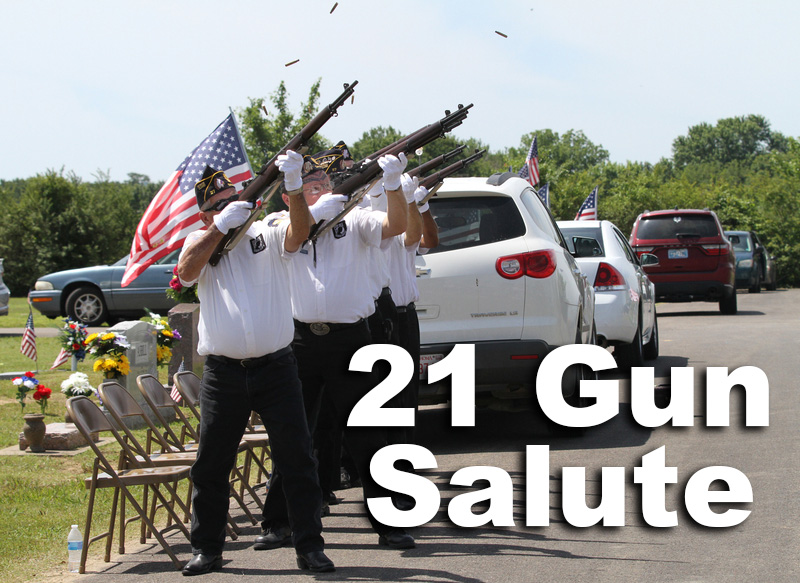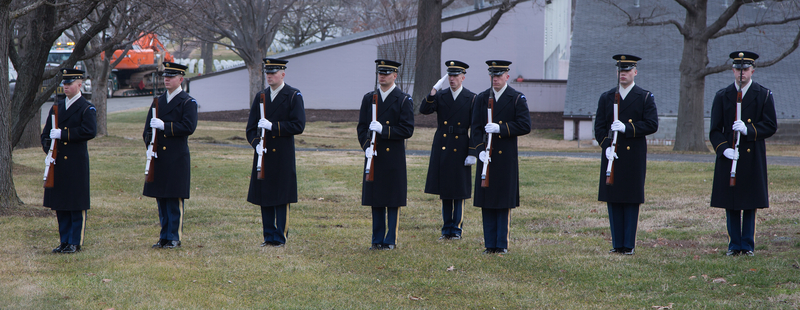A look at the 21-gun salute, its origins, what it means and how to arrange one for a veteran-family member.
Here is a hypothetical. Suppose you and a stranger meet eyes, and you both want to show respect to one another. There is a gesture for that — a tiny nod, with eye contact and the chin moved down and back quickly. The tiny nod, for want of a better name for it, shows someone you assume they’re good and wish them no harm. It is a nice, civilized gesture.
Believe it or not, the tiny nod comes from the same customary tradition as the 21-gun salute.
Origin of the 21-Gun Salute
Mankind has come up with many customs for showing we mean no harm. Waving once meant that you weren’t carrying a weapon. Bowing has fallen out of fashion, but back in the day you would bow to someone you respect. To put yourself in such a vulnerable position before someone was to show that you don’t wish to fight. The tiny nod is atavistic genuflexion — a throwback to the full bow.
Armed forces have a special need to demonstrate they mean no harm in some situations. They don’t want to accidentally start a fight, after all. Ancient warriors would point their spears down or sheathe their swords before approaching a friendly party. The salute itself dates back to the days when a knight would raise his visor with his right hand. In that gesture he revealed his identity while making it harder to draw his sword.
With gunpowder came the need for a new version of saluting. For the captain of a man-of-war to demonstrate he had no intention of attacking, this meant firing all of his ship’s guns into the sea. It took at least a couple of minutes to reload a naval cannon, so firing every one on board made the ship perfectly vulnerable.
What’s so Special About the Number 21?

Early on, the standard number of guns on a British ship was seven. Discharging all seven guns thus became the proper salute before peacefully approaching a foreign shore. Naval custom called for a “gun for gun” salute, but cannons on land could fire more rapidly than ones on a ship, as it was easier to keep gunpowder dry there. Out of respect, forts would fire three shots for every one a ship did: 21 total.
The significance of the number seven wasn’t only limited to a ship’s cannonry. Astrologically it was known as the number of planets, as well as days between lunar phases. Biblically it stood for the day that God rested after creating the cosmos. Seven is still thought of as an auspicious number — just ask around any roulette table.
What Does the 21-Gun Salute Mean in America?
The 21-gun salute is the most commonly recognized gun salute in the world. In America we issue the salute on Memorial Day, when the president arrives and departs, in honor of the flag, and in honor of visiting foreign heads of state or members of royal families. Salutes with fewer guns are performed for less consequential figures. The vice-president gets 19; a governor gets 17; a lieutenant general gets 15, and so on. (It is always an odd number, as even numbers are traditionally associated with death.)
It is important not to confuse the 21-gun salute with the three-volley salute. The latter is performed at military funerals. The custom dates back centuries ago to when rival armies paused battle to bury their dead. Three volleys fired into the air marked the end of observances and the resumption of fighting.
America did not always perform the 21-gun salute. In 1810 the “national salute” was created to equal the number of states in the union, which then totalled 17. Today 50 shots are fired. We adopted the internationally recognized 21-gun salute in 1875, although the practice of firing 21 guns for the “Presidential Salute” had already been established in 1842.
Military Funeral Honors for Servicemen and Women
The Department of Defense helps facilitate funeral honors for veterans as a show of gratitude for the service of those men and women. Most veterans who served honorably qualify for military funeral honors. If you have a family member or friend that served and you’d like to arrange funeral options, you can contact the appropriate branch and learn more at this military’s website here.
What Does the 21-Gun Salute Mean in Other Countries?
The 21-gun salute shares similar significance throughout the world. It nearly always honors a country’s national day. Canada performs it on Canada Day, France performs it on Bastille Day, and the People’s Republic of China performs it on the National Day of the People’s Republic of China. (They like to keep things wordy over there in China.) Presidents, prime ministers, and royalty can expect a 21-gun salute when they visit most civilized nations.
Very few people are so important that they should expect more than 21 shots fired in their honor. The King-Emperor of India is an exception, however. He must have had to plug his ears for the Imperial Salute — 101 shots, one for every dalmation!
—
Is it respectful for you to perform your own 21-gun salute? Well, certainly not if you are attending the arrival of a foreign head of state. You may be very excited that the Prime Minister of the United Kingdom is visiting your hometown, but firing a gun into the air in their presence is not going to prove conducive to your health.



